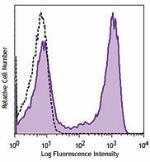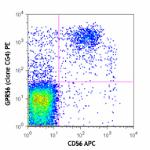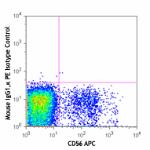- Clone
- CG4 (See other available formats)
- Regulatory Status
- RUO
- Other Names
- TM7XN1
- Isotype
- Mouse IgG1, κ
- Barcode Sequence
- GCCTAGTTTCCGTTT
- Ave. Rating
- Submit a Review
- Product Citations
- publications
GPR56, also known as TM7XN1, is an orphan G-protein-coupled receptor (GPCR) containing seven transmembrane domains and a mucin-like domain in the N-terminal region. The total length of the human GPR56 gene is approximately 15 kb, and it consists of 13 exons and encodes 693 amino acids. GPR56 is expressed in a wide range of tissues, such as brain, thyroid gland, and heart. Mutations in human GPR56 gene were found to cause a specific brain malformation called bilateral frontoparietal polymicrogyria. Recently, GPR56 was found specifically expressed on cytotoxic NK and T lymphocytes, including CD8+, CD4+, and γδ T cells, which might affect the migratory properties of these cells. GPR56 was also found significantly downregulated in some cancer cells, suggesting that it may play a role in growth suppression and cancer metastasis.
Product DetailsProduct Details
- Verified Reactivity
- Human, Mouse
- Antibody Type
- Monoclonal
- Host Species
- Mouse
- Immunogen
- Human GPR56-mouse Fc fusion protein
- Formulation
- Phosphate-buffered solution, pH 7.2, containing 0.09% sodium azide and EDTA
- Preparation
- The antibody was purified by chromatography and conjugated with TotalSeq™-D oligomer under optimal conditions.
- Concentration
- 0.5 mg/mL
- Storage & Handling
- The antibody solution should be stored undiluted between 2°C and 8°C. Do not freeze.
- Application
-
PG - Quality tested
- Recommended Usage
-
Each lot of this antibody is quality control tested by immunofluorescent staining with flow cytometric analysis and the oligomer sequence is confirmed by sequencing. TotalSeq™-D antibodies are compatible with Mission Bio’s Tapestri Single-Cell Sequencing Platform for simultaneous detection of DNA and Protein.
To maximize performance, it is strongly recommended that the reagent be titrated for each application, and that you centrifuge the antibody dilution before adding to the cells at 14,000xg at 2 - 8°C for 10 minutes. Carefully pipette out the liquid avoiding the bottom of the tube and add to the cell suspension. For Proteogenomics analysis, the suggested starting amount of this reagent for titration is ≤ 1.0 µg per million cells in 100 µL volume. Refer to the corresponding TotalSeq™ protocol for specific staining instructions.
Buyer is solely responsible for determining whether Buyer has all intellectual property rights that are necessary for Buyer's intended uses of the BioLegend TotalSeq™ products. For example, for any technology platform Buyer uses with TotalSeq™, it is Buyer's sole responsibility to determine whether it has all necessary third party intellectual property rights to use that platform and TotalSeq™ with that platform. - Application Notes
-
Clone CG4 cross-reacts with mouse1.
- Additional Product Notes
-
TotalSeq™-D reagents are designed to profile protein expression at single cell level. The Mission Bio Tapestri platform and sequencer (e.g. Illumina analyzers) are required. Please contact technical support for more information, or visit biolegend.com/totalseq/single-cell-dna
The barcode flanking sequences are CGAGATGACTACGCTACTCATGG (PCR handle), and GAGCCGATCTAGTATCTCAGT*C*G (capture sequence). * indicates a phosphorothioated bond, to prevent nuclease degradation.
View more applications data for this product in our Application Technical Notes. -
Application References
(PubMed link indicates BioLegend citation) -
- Rao TN, et al. 2015. Stem Cell Res. 14:307. (FC) PubMed
- RRID
-
AB_2936568 (BioLegend Cat. No. 358213)
Antigen Details
- Structure
- Contains seven transmembrane domains and a mucin-like domain in the N-terminal region
- Distribution
-
T cells, NK cells, wide range of tissues such as brain, thyroid gland, and heart
- Function
- May be involved in immune cell migration, cancer cell growth metastasis, and neuron development
- Cell Type
- NK cells, T cells
- Biology Area
- Apoptosis/Tumor Suppressors/Cell Death, Cell Adhesion, Cell Biology, Immunology
- Molecular Family
- Adhesion Molecules
- Antigen References
-
1. Peng YM, et al. 2011. J. Leukoc. Biol. 90:735.
2. Shashidhar S, et al. 2005. Oncogene 24:1673.
3. Piao X, et al. 2004. Science 303:2033.
4. Liu M, et al. 1999. Genomics 55:296. - Gene ID
- 9289 View all products for this Gene ID
- UniProt
- View information about GPR56 on UniProt.org
Related Pages & Pathways
Pages
Related FAQs
Other Formats
View All GPR56 Reagents Request Custom Conjugation| Description | Clone | Applications |
|---|---|---|
| Purified anti-human GPR56 | CG4 | FC |
| PE anti-human GPR56 | CG4 | FC |
| PE/Cyanine7 anti-human GPR56 | CG4 | FC |
| TotalSeq™-A0912 anti-human GPR56 | CG4 | PG |
| TotalSeq™-C0912 anti-human GPR56 | CG4 | PG |
| TotalSeq™-B0912 anti-human GPR56 | CG4 | PG |
| TotalSeq™-D0912 anti-human GPR56 | CG4 | PG |
Compare Data Across All Formats
This data display is provided for general comparisons between formats.
Your actual data may vary due to variations in samples, target cells, instruments and their settings, staining conditions, and other factors.
If you need assistance with selecting the best format contact our expert technical support team.
-
Purified anti-human GPR56

Human peripheral blood lymphocytes were stained with purifie... -
PE anti-human GPR56

Human peripheral blood lymphocytes were stained with CD56 AP... 
-
PE/Cyanine7 anti-human GPR56

Human peripheral blood lymphocytes were stained with CD56 AP... -
TotalSeq™-A0912 anti-human GPR56
-
TotalSeq™-C0912 anti-human GPR56
-
TotalSeq™-B0912 anti-human GPR56
-
TotalSeq™-D0912 anti-human GPR56












Follow Us